Big Data Analysis: Examples of Implementation and Application Report
VerifiedAdded on 2020/03/01
|11
|2666
|101
Report
AI Summary
This report provides a comprehensive overview of Big Data, exploring its implementation and application in various real-life scenarios. It begins with an introduction to Big Data, defining it as unstructured and structured data of large volume used to make strategic business moves and better decisions. The report then delves into specific examples, including Big Data's contributions to healthcare, learning, and transportation. It differentiates between online and offline Big Data, highlighting their characteristics and applications. Furthermore, the report addresses the problems associated with traditional data management systems when handling Big Data, such as acquisition time, cost, and commitment issues. It also discusses the failures of traditional data management techniques, like the difficulties in setting up data warehouses and the high cost of expertise in Online Analytical Processing. The report concludes by recommending the use of Big Data technology for organizations dealing with large datasets, particularly focusing on online big data solutions. The report references several academic sources to support its claims and provides a well-rounded perspective on the subject.
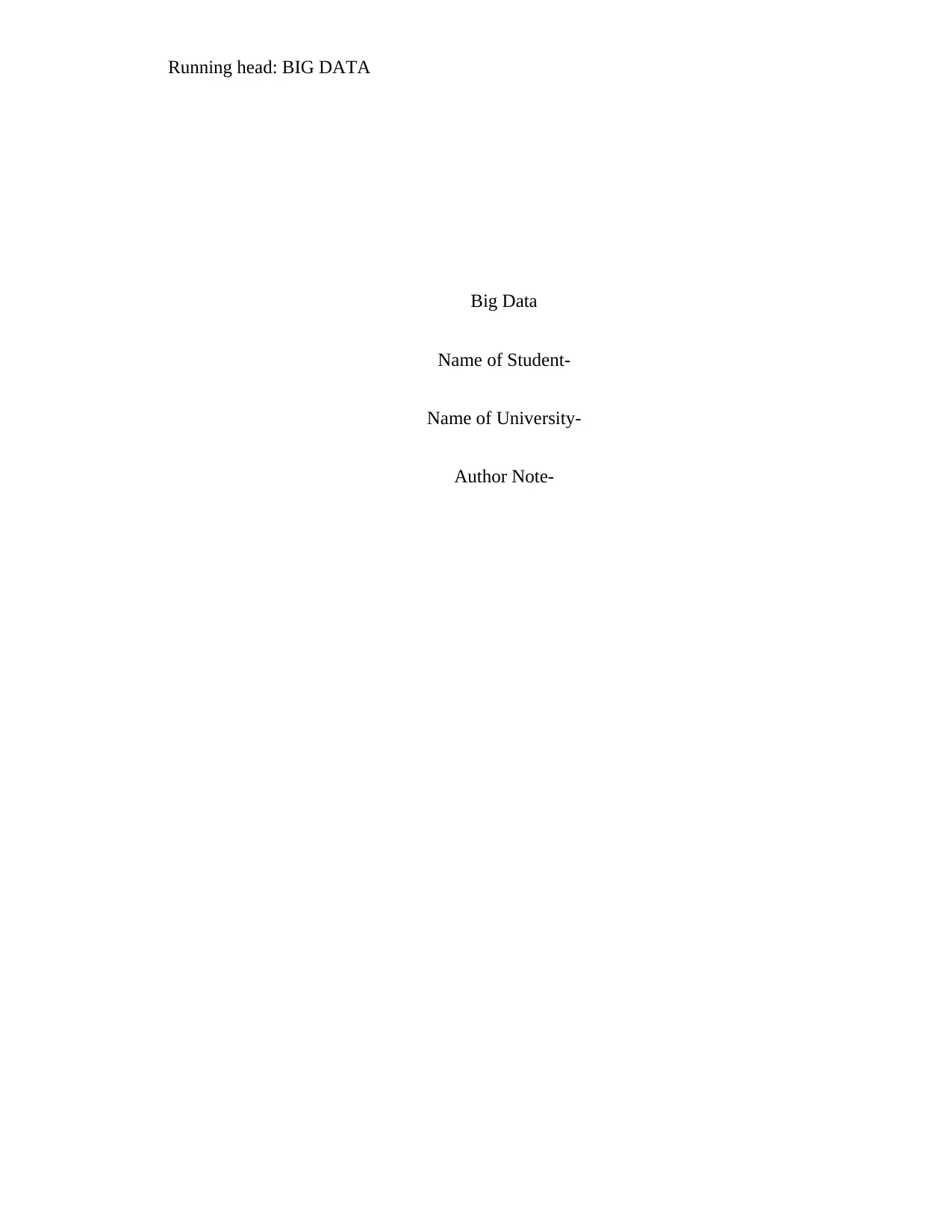
Running head: BIG DATA
Big Data
Name of Student-
Name of University-
Author Note-
Big Data
Name of Student-
Name of University-
Author Note-
Paraphrase This Document
Need a fresh take? Get an instant paraphrase of this document with our AI Paraphraser
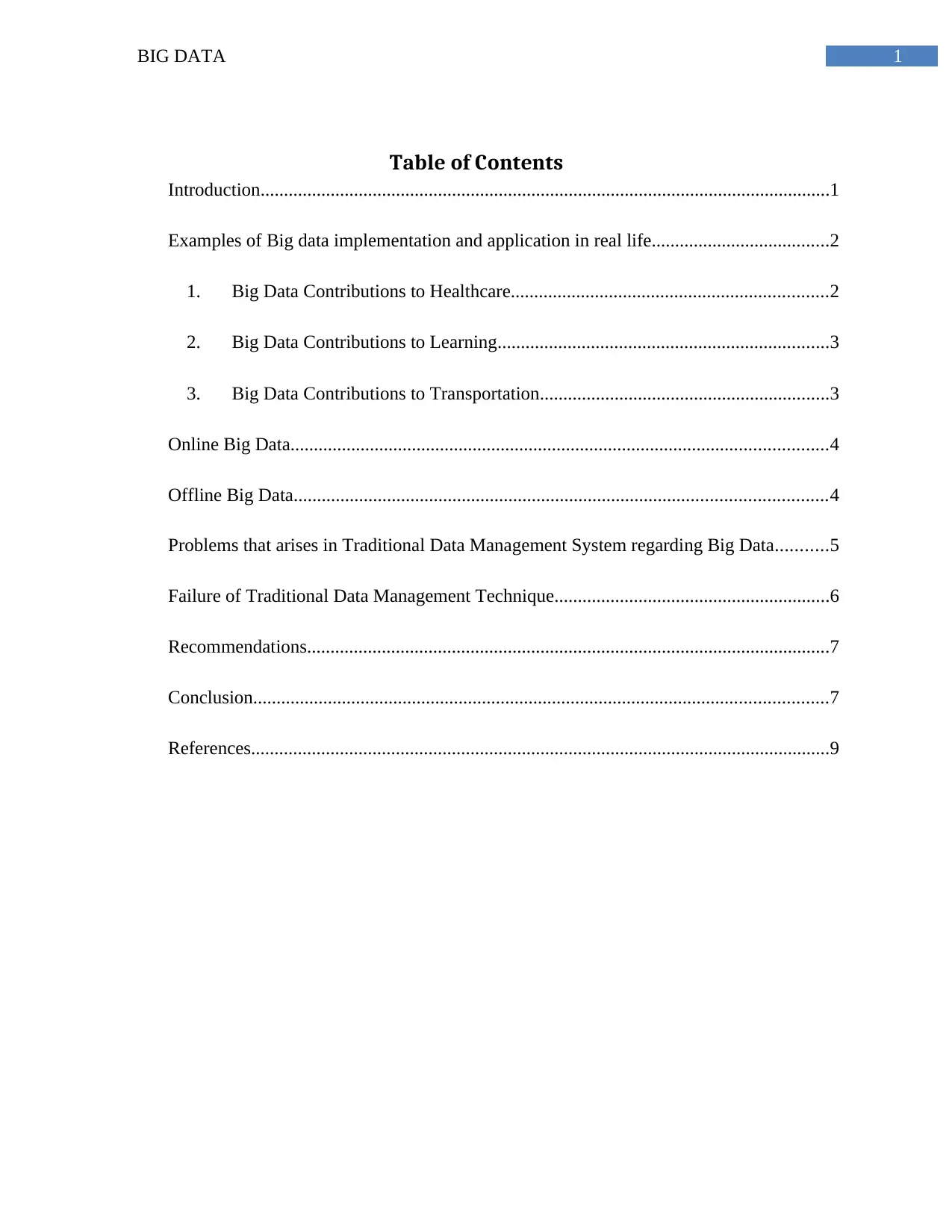
1BIG DATA
Table of Contents
Introduction..........................................................................................................................1
Examples of Big data implementation and application in real life......................................2
1. Big Data Contributions to Healthcare....................................................................2
2. Big Data Contributions to Learning.......................................................................3
3. Big Data Contributions to Transportation..............................................................3
Online Big Data...................................................................................................................4
Offline Big Data..................................................................................................................4
Problems that arises in Traditional Data Management System regarding Big Data...........5
Failure of Traditional Data Management Technique...........................................................6
Recommendations................................................................................................................7
Conclusion...........................................................................................................................7
References............................................................................................................................9
Table of Contents
Introduction..........................................................................................................................1
Examples of Big data implementation and application in real life......................................2
1. Big Data Contributions to Healthcare....................................................................2
2. Big Data Contributions to Learning.......................................................................3
3. Big Data Contributions to Transportation..............................................................3
Online Big Data...................................................................................................................4
Offline Big Data..................................................................................................................4
Problems that arises in Traditional Data Management System regarding Big Data...........5
Failure of Traditional Data Management Technique...........................................................6
Recommendations................................................................................................................7
Conclusion...........................................................................................................................7
References............................................................................................................................9
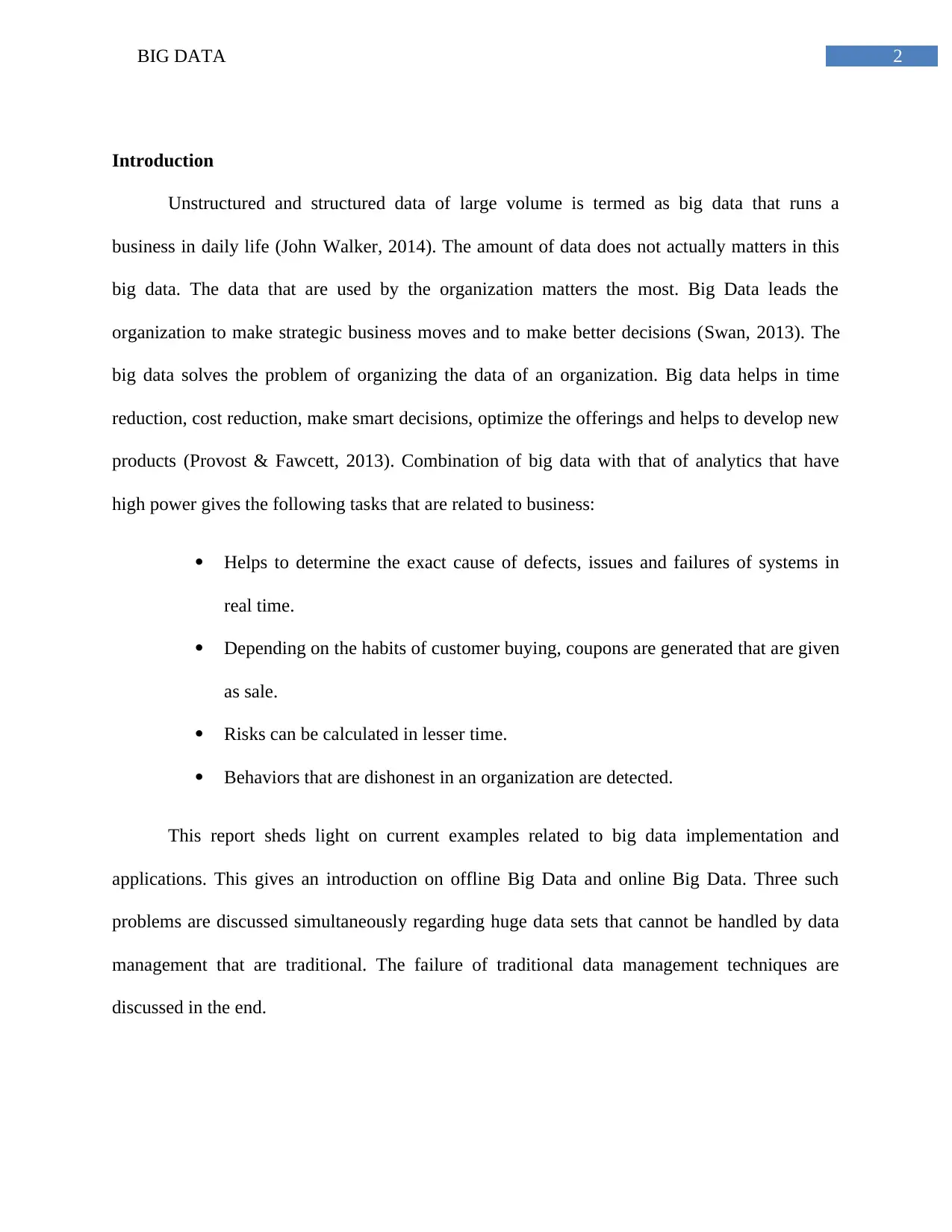
2BIG DATA
Introduction
Unstructured and structured data of large volume is termed as big data that runs a
business in daily life (John Walker, 2014). The amount of data does not actually matters in this
big data. The data that are used by the organization matters the most. Big Data leads the
organization to make strategic business moves and to make better decisions (Swan, 2013). The
big data solves the problem of organizing the data of an organization. Big data helps in time
reduction, cost reduction, make smart decisions, optimize the offerings and helps to develop new
products (Provost & Fawcett, 2013). Combination of big data with that of analytics that have
high power gives the following tasks that are related to business:
Helps to determine the exact cause of defects, issues and failures of systems in
real time.
Depending on the habits of customer buying, coupons are generated that are given
as sale.
Risks can be calculated in lesser time.
Behaviors that are dishonest in an organization are detected.
This report sheds light on current examples related to big data implementation and
applications. This gives an introduction on offline Big Data and online Big Data. Three such
problems are discussed simultaneously regarding huge data sets that cannot be handled by data
management that are traditional. The failure of traditional data management techniques are
discussed in the end.
Introduction
Unstructured and structured data of large volume is termed as big data that runs a
business in daily life (John Walker, 2014). The amount of data does not actually matters in this
big data. The data that are used by the organization matters the most. Big Data leads the
organization to make strategic business moves and to make better decisions (Swan, 2013). The
big data solves the problem of organizing the data of an organization. Big data helps in time
reduction, cost reduction, make smart decisions, optimize the offerings and helps to develop new
products (Provost & Fawcett, 2013). Combination of big data with that of analytics that have
high power gives the following tasks that are related to business:
Helps to determine the exact cause of defects, issues and failures of systems in
real time.
Depending on the habits of customer buying, coupons are generated that are given
as sale.
Risks can be calculated in lesser time.
Behaviors that are dishonest in an organization are detected.
This report sheds light on current examples related to big data implementation and
applications. This gives an introduction on offline Big Data and online Big Data. Three such
problems are discussed simultaneously regarding huge data sets that cannot be handled by data
management that are traditional. The failure of traditional data management techniques are
discussed in the end.
⊘ This is a preview!⊘
Do you want full access?
Subscribe today to unlock all pages.

Trusted by 1+ million students worldwide
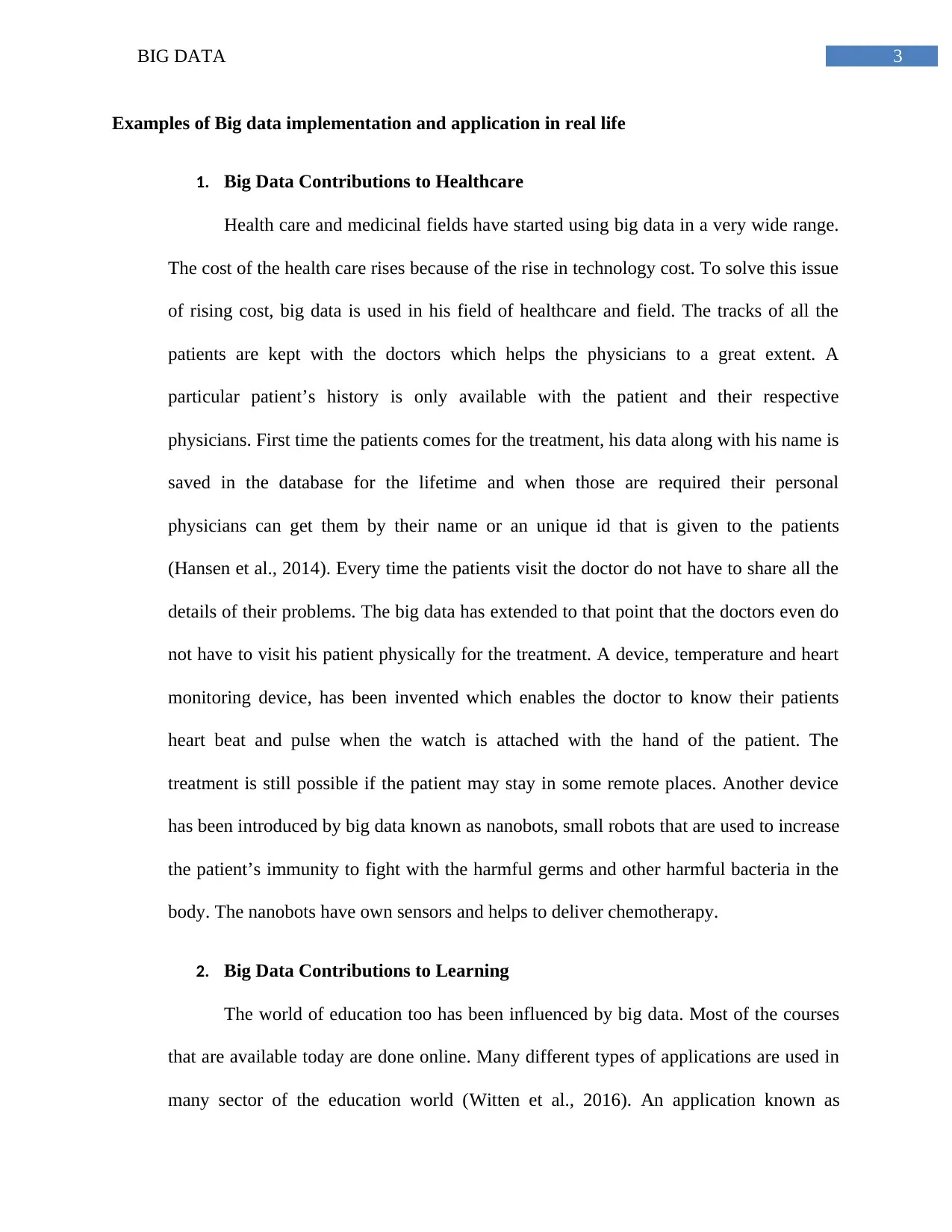
3BIG DATA
Examples of Big data implementation and application in real life
1. Big Data Contributions to Healthcare
Health care and medicinal fields have started using big data in a very wide range.
The cost of the health care rises because of the rise in technology cost. To solve this issue
of rising cost, big data is used in his field of healthcare and field. The tracks of all the
patients are kept with the doctors which helps the physicians to a great extent. A
particular patient’s history is only available with the patient and their respective
physicians. First time the patients comes for the treatment, his data along with his name is
saved in the database for the lifetime and when those are required their personal
physicians can get them by their name or an unique id that is given to the patients
(Hansen et al., 2014). Every time the patients visit the doctor do not have to share all the
details of their problems. The big data has extended to that point that the doctors even do
not have to visit his patient physically for the treatment. A device, temperature and heart
monitoring device, has been invented which enables the doctor to know their patients
heart beat and pulse when the watch is attached with the hand of the patient. The
treatment is still possible if the patient may stay in some remote places. Another device
has been introduced by big data known as nanobots, small robots that are used to increase
the patient’s immunity to fight with the harmful germs and other harmful bacteria in the
body. The nanobots have own sensors and helps to deliver chemotherapy.
2. Big Data Contributions to Learning
The world of education too has been influenced by big data. Most of the courses
that are available today are done online. Many different types of applications are used in
many sector of the education world (Witten et al., 2016). An application known as
Examples of Big data implementation and application in real life
1. Big Data Contributions to Healthcare
Health care and medicinal fields have started using big data in a very wide range.
The cost of the health care rises because of the rise in technology cost. To solve this issue
of rising cost, big data is used in his field of healthcare and field. The tracks of all the
patients are kept with the doctors which helps the physicians to a great extent. A
particular patient’s history is only available with the patient and their respective
physicians. First time the patients comes for the treatment, his data along with his name is
saved in the database for the lifetime and when those are required their personal
physicians can get them by their name or an unique id that is given to the patients
(Hansen et al., 2014). Every time the patients visit the doctor do not have to share all the
details of their problems. The big data has extended to that point that the doctors even do
not have to visit his patient physically for the treatment. A device, temperature and heart
monitoring device, has been invented which enables the doctor to know their patients
heart beat and pulse when the watch is attached with the hand of the patient. The
treatment is still possible if the patient may stay in some remote places. Another device
has been introduced by big data known as nanobots, small robots that are used to increase
the patient’s immunity to fight with the harmful germs and other harmful bacteria in the
body. The nanobots have own sensors and helps to deliver chemotherapy.
2. Big Data Contributions to Learning
The world of education too has been influenced by big data. Most of the courses
that are available today are done online. Many different types of applications are used in
many sector of the education world (Witten et al., 2016). An application known as
Paraphrase This Document
Need a fresh take? Get an instant paraphrase of this document with our AI Paraphraser
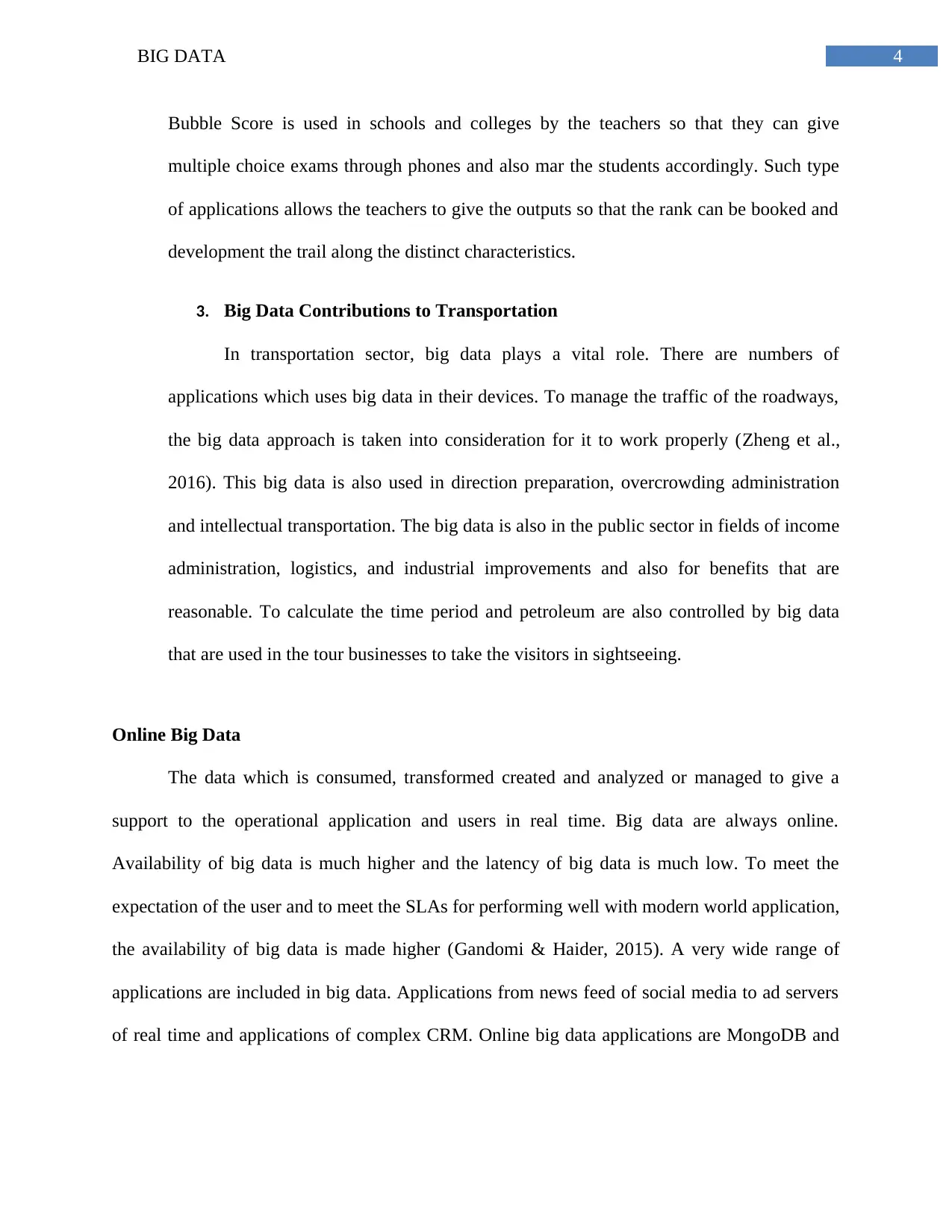
4BIG DATA
Bubble Score is used in schools and colleges by the teachers so that they can give
multiple choice exams through phones and also mar the students accordingly. Such type
of applications allows the teachers to give the outputs so that the rank can be booked and
development the trail along the distinct characteristics.
3. Big Data Contributions to Transportation
In transportation sector, big data plays a vital role. There are numbers of
applications which uses big data in their devices. To manage the traffic of the roadways,
the big data approach is taken into consideration for it to work properly (Zheng et al.,
2016). This big data is also used in direction preparation, overcrowding administration
and intellectual transportation. The big data is also in the public sector in fields of income
administration, logistics, and industrial improvements and also for benefits that are
reasonable. To calculate the time period and petroleum are also controlled by big data
that are used in the tour businesses to take the visitors in sightseeing.
Online Big Data
The data which is consumed, transformed created and analyzed or managed to give a
support to the operational application and users in real time. Big data are always online.
Availability of big data is much higher and the latency of big data is much low. To meet the
expectation of the user and to meet the SLAs for performing well with modern world application,
the availability of big data is made higher (Gandomi & Haider, 2015). A very wide range of
applications are included in big data. Applications from news feed of social media to ad servers
of real time and applications of complex CRM. Online big data applications are MongoDB and
Bubble Score is used in schools and colleges by the teachers so that they can give
multiple choice exams through phones and also mar the students accordingly. Such type
of applications allows the teachers to give the outputs so that the rank can be booked and
development the trail along the distinct characteristics.
3. Big Data Contributions to Transportation
In transportation sector, big data plays a vital role. There are numbers of
applications which uses big data in their devices. To manage the traffic of the roadways,
the big data approach is taken into consideration for it to work properly (Zheng et al.,
2016). This big data is also used in direction preparation, overcrowding administration
and intellectual transportation. The big data is also in the public sector in fields of income
administration, logistics, and industrial improvements and also for benefits that are
reasonable. To calculate the time period and petroleum are also controlled by big data
that are used in the tour businesses to take the visitors in sightseeing.
Online Big Data
The data which is consumed, transformed created and analyzed or managed to give a
support to the operational application and users in real time. Big data are always online.
Availability of big data is much higher and the latency of big data is much low. To meet the
expectation of the user and to meet the SLAs for performing well with modern world application,
the availability of big data is made higher (Gandomi & Haider, 2015). A very wide range of
applications are included in big data. Applications from news feed of social media to ad servers
of real time and applications of complex CRM. Online big data applications are MongoDB and
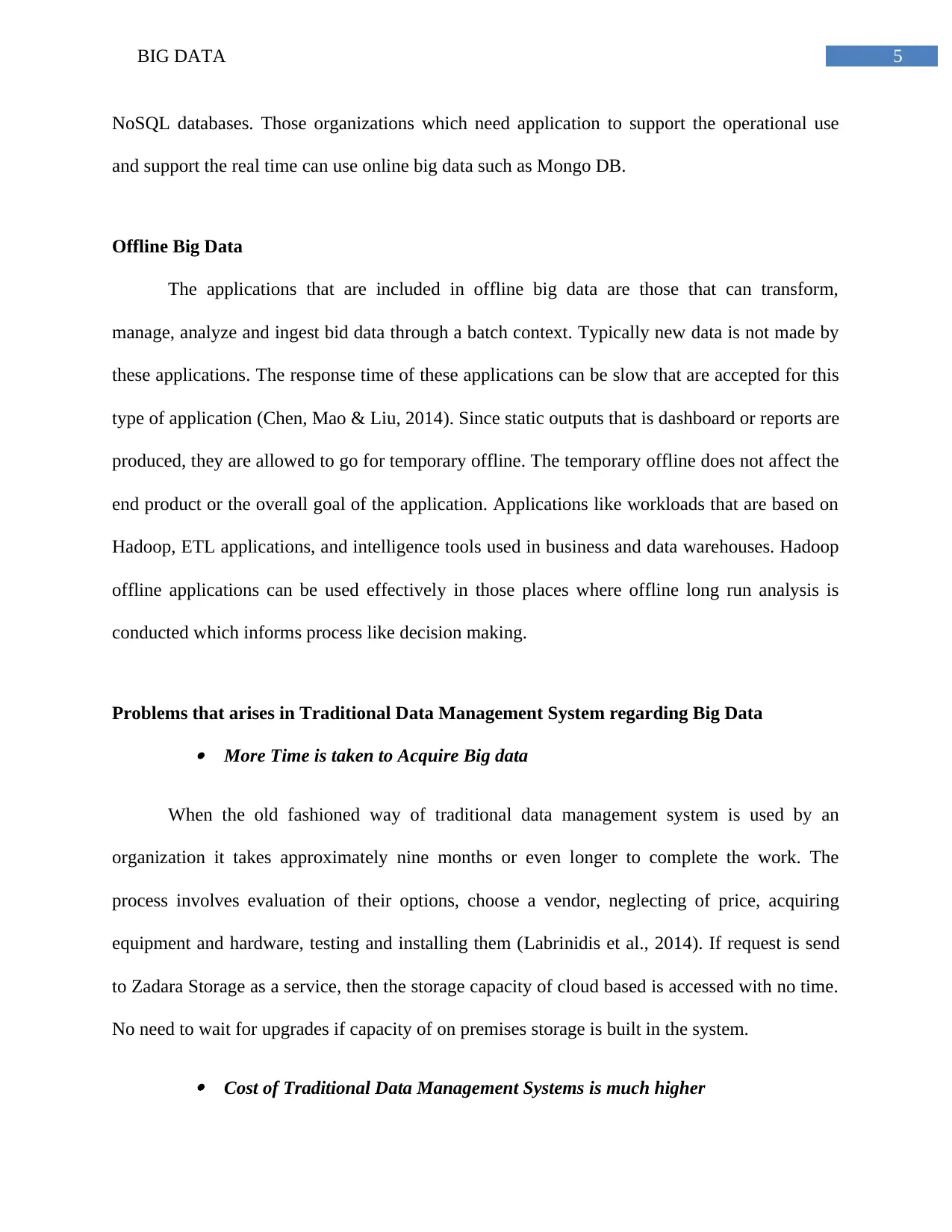
5BIG DATA
NoSQL databases. Those organizations which need application to support the operational use
and support the real time can use online big data such as Mongo DB.
Offline Big Data
The applications that are included in offline big data are those that can transform,
manage, analyze and ingest bid data through a batch context. Typically new data is not made by
these applications. The response time of these applications can be slow that are accepted for this
type of application (Chen, Mao & Liu, 2014). Since static outputs that is dashboard or reports are
produced, they are allowed to go for temporary offline. The temporary offline does not affect the
end product or the overall goal of the application. Applications like workloads that are based on
Hadoop, ETL applications, and intelligence tools used in business and data warehouses. Hadoop
offline applications can be used effectively in those places where offline long run analysis is
conducted which informs process like decision making.
Problems that arises in Traditional Data Management System regarding Big Data
More Time is taken to Acquire Big data
When the old fashioned way of traditional data management system is used by an
organization it takes approximately nine months or even longer to complete the work. The
process involves evaluation of their options, choose a vendor, neglecting of price, acquiring
equipment and hardware, testing and installing them (Labrinidis et al., 2014). If request is send
to Zadara Storage as a service, then the storage capacity of cloud based is accessed with no time.
No need to wait for upgrades if capacity of on premises storage is built in the system. Cost of Traditional Data Management Systems is much higher
NoSQL databases. Those organizations which need application to support the operational use
and support the real time can use online big data such as Mongo DB.
Offline Big Data
The applications that are included in offline big data are those that can transform,
manage, analyze and ingest bid data through a batch context. Typically new data is not made by
these applications. The response time of these applications can be slow that are accepted for this
type of application (Chen, Mao & Liu, 2014). Since static outputs that is dashboard or reports are
produced, they are allowed to go for temporary offline. The temporary offline does not affect the
end product or the overall goal of the application. Applications like workloads that are based on
Hadoop, ETL applications, and intelligence tools used in business and data warehouses. Hadoop
offline applications can be used effectively in those places where offline long run analysis is
conducted which informs process like decision making.
Problems that arises in Traditional Data Management System regarding Big Data
More Time is taken to Acquire Big data
When the old fashioned way of traditional data management system is used by an
organization it takes approximately nine months or even longer to complete the work. The
process involves evaluation of their options, choose a vendor, neglecting of price, acquiring
equipment and hardware, testing and installing them (Labrinidis et al., 2014). If request is send
to Zadara Storage as a service, then the storage capacity of cloud based is accessed with no time.
No need to wait for upgrades if capacity of on premises storage is built in the system. Cost of Traditional Data Management Systems is much higher
⊘ This is a preview!⊘
Do you want full access?
Subscribe today to unlock all pages.

Trusted by 1+ million students worldwide
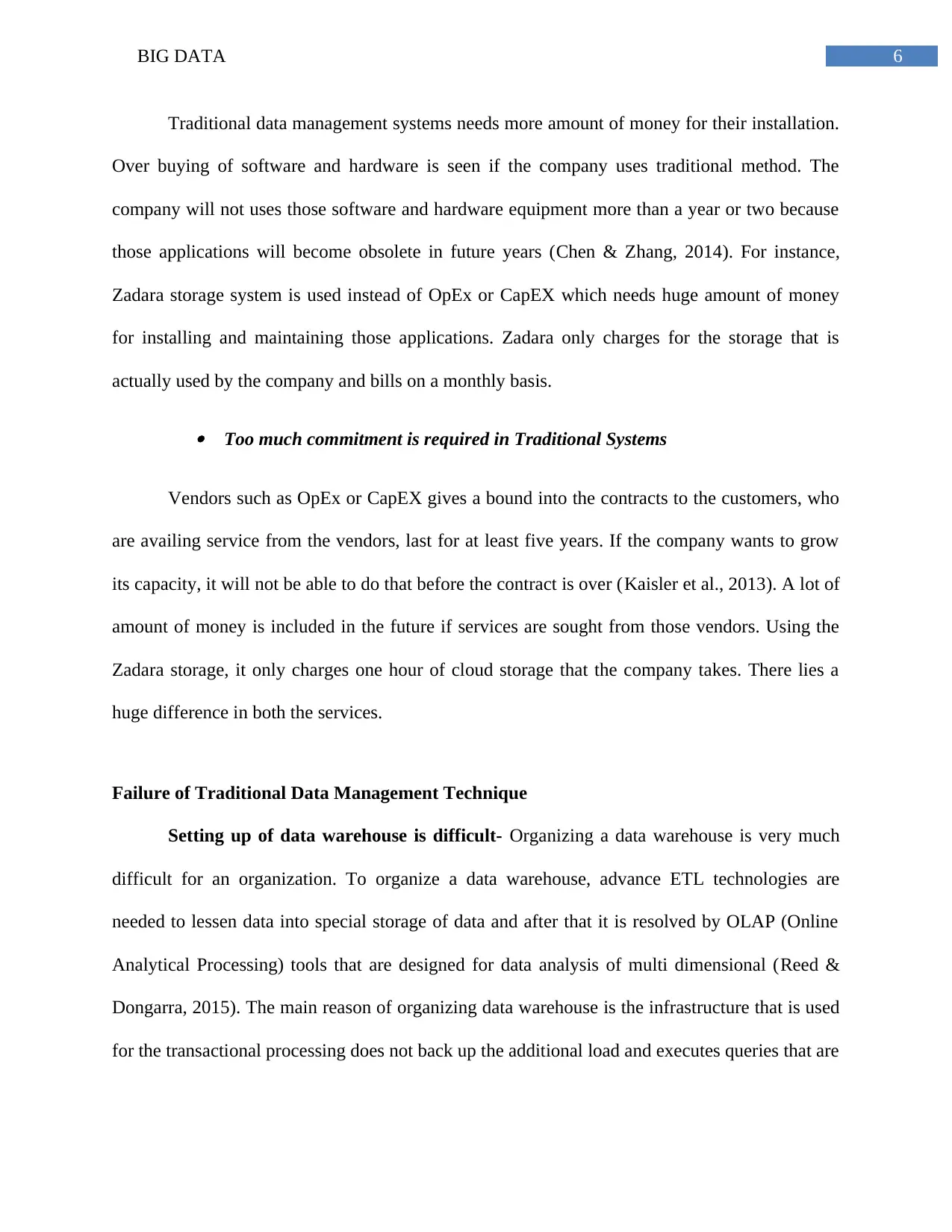
6BIG DATA
Traditional data management systems needs more amount of money for their installation.
Over buying of software and hardware is seen if the company uses traditional method. The
company will not uses those software and hardware equipment more than a year or two because
those applications will become obsolete in future years (Chen & Zhang, 2014). For instance,
Zadara storage system is used instead of OpEx or CapEX which needs huge amount of money
for installing and maintaining those applications. Zadara only charges for the storage that is
actually used by the company and bills on a monthly basis. Too much commitment is required in Traditional Systems
Vendors such as OpEx or CapEX gives a bound into the contracts to the customers, who
are availing service from the vendors, last for at least five years. If the company wants to grow
its capacity, it will not be able to do that before the contract is over (Kaisler et al., 2013). A lot of
amount of money is included in the future if services are sought from those vendors. Using the
Zadara storage, it only charges one hour of cloud storage that the company takes. There lies a
huge difference in both the services.
Failure of Traditional Data Management Technique
Setting up of data warehouse is difficult- Organizing a data warehouse is very much
difficult for an organization. To organize a data warehouse, advance ETL technologies are
needed to lessen data into special storage of data and after that it is resolved by OLAP (Online
Analytical Processing) tools that are designed for data analysis of multi dimensional (Reed &
Dongarra, 2015). The main reason of organizing data warehouse is the infrastructure that is used
for the transactional processing does not back up the additional load and executes queries that are
Traditional data management systems needs more amount of money for their installation.
Over buying of software and hardware is seen if the company uses traditional method. The
company will not uses those software and hardware equipment more than a year or two because
those applications will become obsolete in future years (Chen & Zhang, 2014). For instance,
Zadara storage system is used instead of OpEx or CapEX which needs huge amount of money
for installing and maintaining those applications. Zadara only charges for the storage that is
actually used by the company and bills on a monthly basis. Too much commitment is required in Traditional Systems
Vendors such as OpEx or CapEX gives a bound into the contracts to the customers, who
are availing service from the vendors, last for at least five years. If the company wants to grow
its capacity, it will not be able to do that before the contract is over (Kaisler et al., 2013). A lot of
amount of money is included in the future if services are sought from those vendors. Using the
Zadara storage, it only charges one hour of cloud storage that the company takes. There lies a
huge difference in both the services.
Failure of Traditional Data Management Technique
Setting up of data warehouse is difficult- Organizing a data warehouse is very much
difficult for an organization. To organize a data warehouse, advance ETL technologies are
needed to lessen data into special storage of data and after that it is resolved by OLAP (Online
Analytical Processing) tools that are designed for data analysis of multi dimensional (Reed &
Dongarra, 2015). The main reason of organizing data warehouse is the infrastructure that is used
for the transactional processing does not back up the additional load and executes queries that are
Paraphrase This Document
Need a fresh take? Get an instant paraphrase of this document with our AI Paraphraser
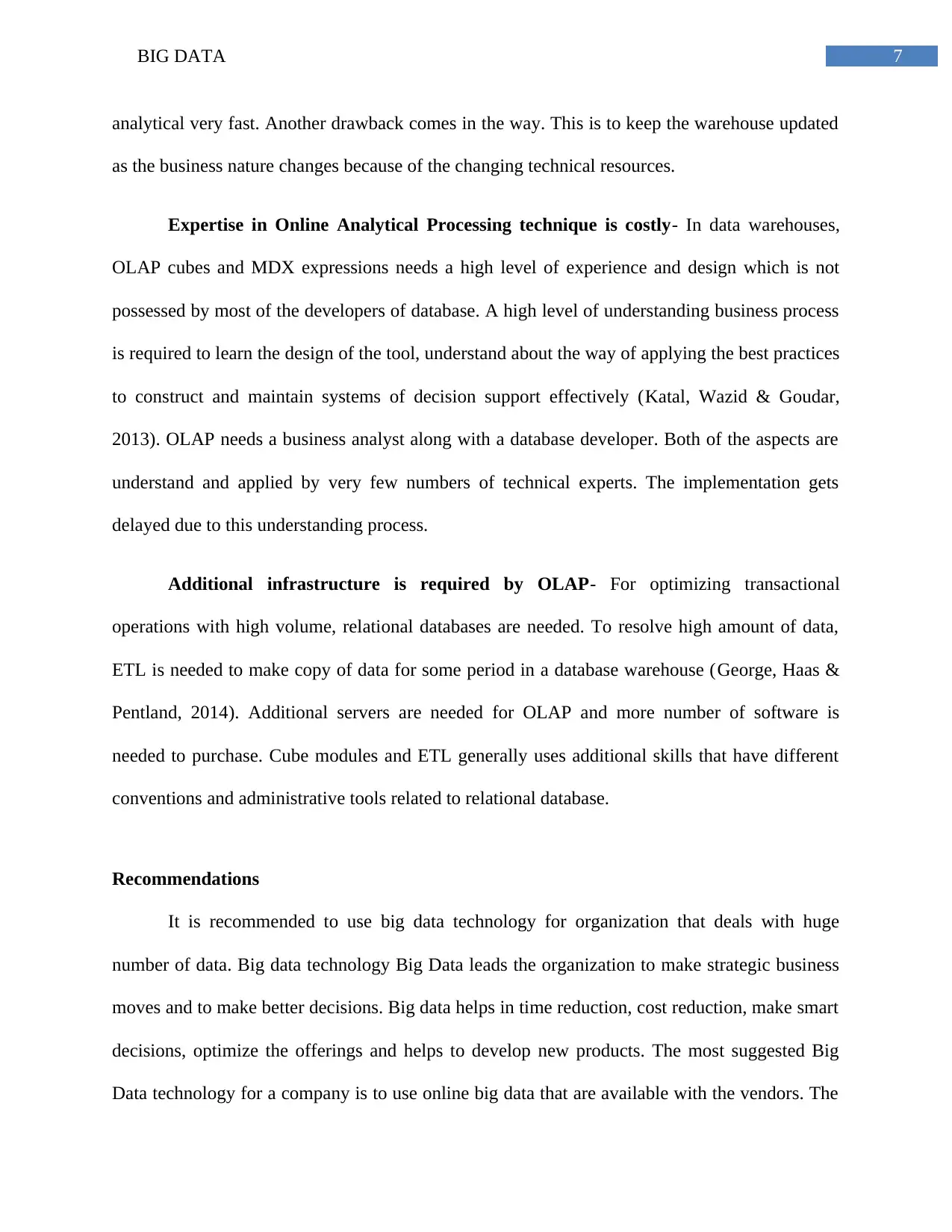
7BIG DATA
analytical very fast. Another drawback comes in the way. This is to keep the warehouse updated
as the business nature changes because of the changing technical resources.
Expertise in Online Analytical Processing technique is costly- In data warehouses,
OLAP cubes and MDX expressions needs a high level of experience and design which is not
possessed by most of the developers of database. A high level of understanding business process
is required to learn the design of the tool, understand about the way of applying the best practices
to construct and maintain systems of decision support effectively (Katal, Wazid & Goudar,
2013). OLAP needs a business analyst along with a database developer. Both of the aspects are
understand and applied by very few numbers of technical experts. The implementation gets
delayed due to this understanding process.
Additional infrastructure is required by OLAP- For optimizing transactional
operations with high volume, relational databases are needed. To resolve high amount of data,
ETL is needed to make copy of data for some period in a database warehouse (George, Haas &
Pentland, 2014). Additional servers are needed for OLAP and more number of software is
needed to purchase. Cube modules and ETL generally uses additional skills that have different
conventions and administrative tools related to relational database.
Recommendations
It is recommended to use big data technology for organization that deals with huge
number of data. Big data technology Big Data leads the organization to make strategic business
moves and to make better decisions. Big data helps in time reduction, cost reduction, make smart
decisions, optimize the offerings and helps to develop new products. The most suggested Big
Data technology for a company is to use online big data that are available with the vendors. The
analytical very fast. Another drawback comes in the way. This is to keep the warehouse updated
as the business nature changes because of the changing technical resources.
Expertise in Online Analytical Processing technique is costly- In data warehouses,
OLAP cubes and MDX expressions needs a high level of experience and design which is not
possessed by most of the developers of database. A high level of understanding business process
is required to learn the design of the tool, understand about the way of applying the best practices
to construct and maintain systems of decision support effectively (Katal, Wazid & Goudar,
2013). OLAP needs a business analyst along with a database developer. Both of the aspects are
understand and applied by very few numbers of technical experts. The implementation gets
delayed due to this understanding process.
Additional infrastructure is required by OLAP- For optimizing transactional
operations with high volume, relational databases are needed. To resolve high amount of data,
ETL is needed to make copy of data for some period in a database warehouse (George, Haas &
Pentland, 2014). Additional servers are needed for OLAP and more number of software is
needed to purchase. Cube modules and ETL generally uses additional skills that have different
conventions and administrative tools related to relational database.
Recommendations
It is recommended to use big data technology for organization that deals with huge
number of data. Big data technology Big Data leads the organization to make strategic business
moves and to make better decisions. Big data helps in time reduction, cost reduction, make smart
decisions, optimize the offerings and helps to develop new products. The most suggested Big
Data technology for a company is to use online big data that are available with the vendors. The
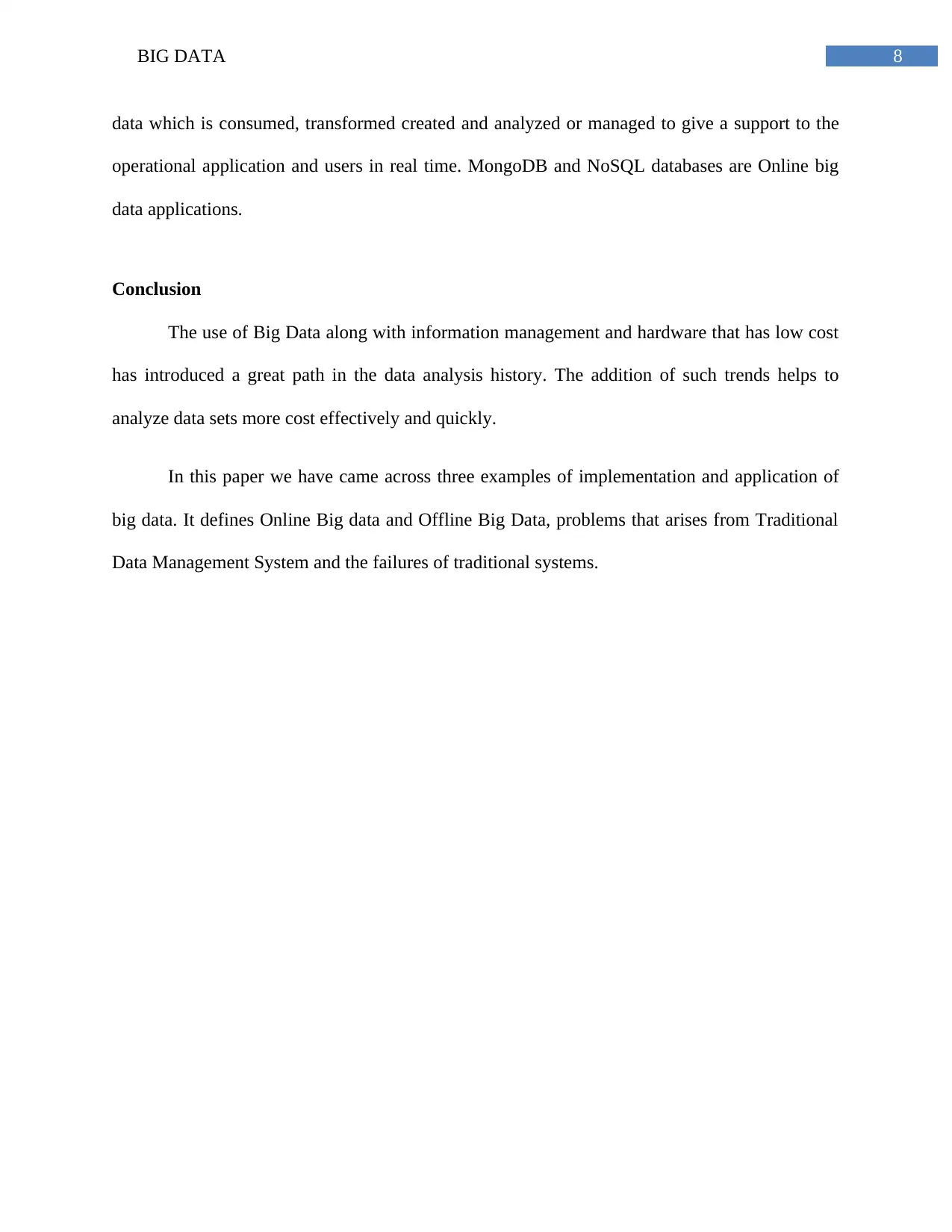
8BIG DATA
data which is consumed, transformed created and analyzed or managed to give a support to the
operational application and users in real time. MongoDB and NoSQL databases are Online big
data applications.
Conclusion
The use of Big Data along with information management and hardware that has low cost
has introduced a great path in the data analysis history. The addition of such trends helps to
analyze data sets more cost effectively and quickly.
In this paper we have came across three examples of implementation and application of
big data. It defines Online Big data and Offline Big Data, problems that arises from Traditional
Data Management System and the failures of traditional systems.
data which is consumed, transformed created and analyzed or managed to give a support to the
operational application and users in real time. MongoDB and NoSQL databases are Online big
data applications.
Conclusion
The use of Big Data along with information management and hardware that has low cost
has introduced a great path in the data analysis history. The addition of such trends helps to
analyze data sets more cost effectively and quickly.
In this paper we have came across three examples of implementation and application of
big data. It defines Online Big data and Offline Big Data, problems that arises from Traditional
Data Management System and the failures of traditional systems.
⊘ This is a preview!⊘
Do you want full access?
Subscribe today to unlock all pages.

Trusted by 1+ million students worldwide
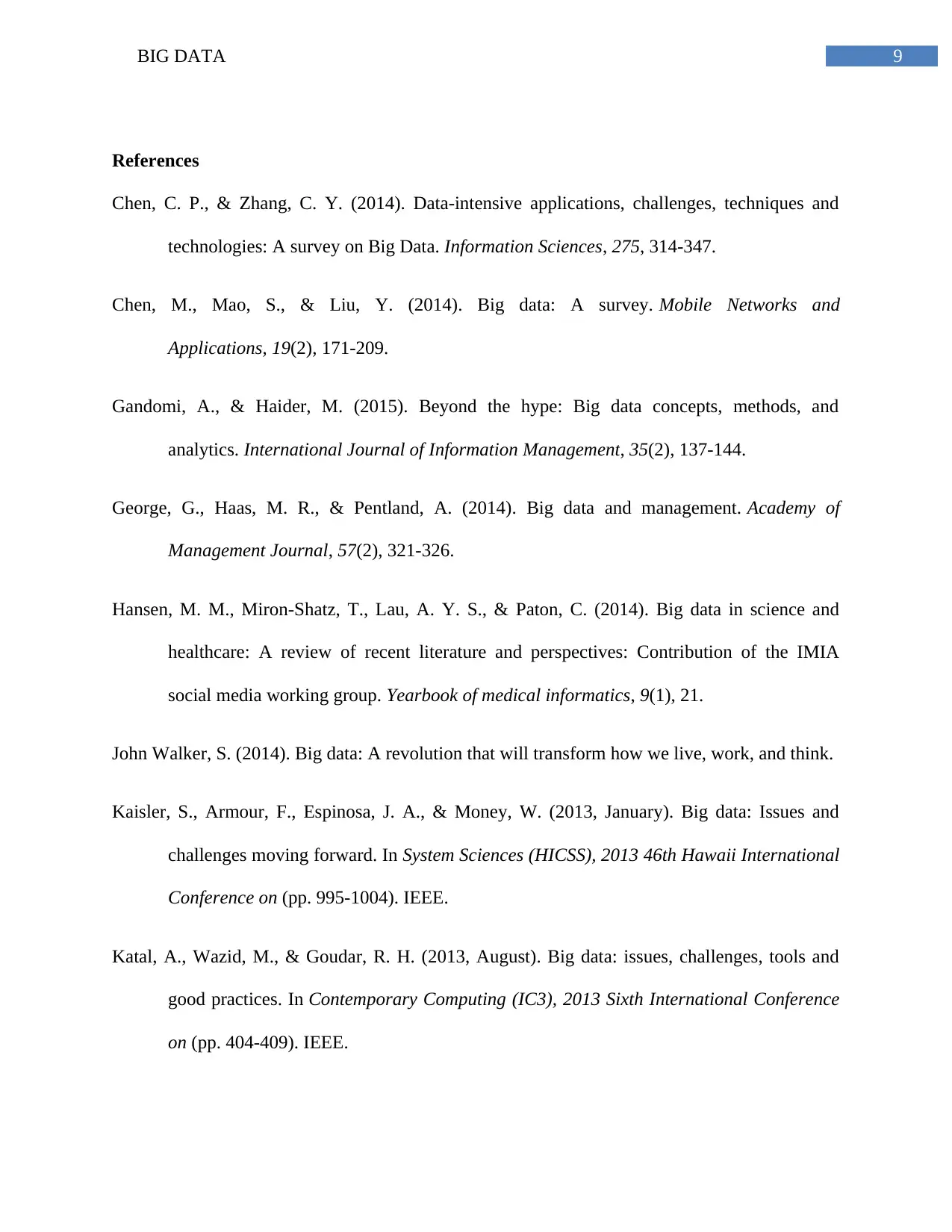
9BIG DATA
References
Chen, C. P., & Zhang, C. Y. (2014). Data-intensive applications, challenges, techniques and
technologies: A survey on Big Data. Information Sciences, 275, 314-347.
Chen, M., Mao, S., & Liu, Y. (2014). Big data: A survey. Mobile Networks and
Applications, 19(2), 171-209.
Gandomi, A., & Haider, M. (2015). Beyond the hype: Big data concepts, methods, and
analytics. International Journal of Information Management, 35(2), 137-144.
George, G., Haas, M. R., & Pentland, A. (2014). Big data and management. Academy of
Management Journal, 57(2), 321-326.
Hansen, M. M., Miron-Shatz, T., Lau, A. Y. S., & Paton, C. (2014). Big data in science and
healthcare: A review of recent literature and perspectives: Contribution of the IMIA
social media working group. Yearbook of medical informatics, 9(1), 21.
John Walker, S. (2014). Big data: A revolution that will transform how we live, work, and think.
Kaisler, S., Armour, F., Espinosa, J. A., & Money, W. (2013, January). Big data: Issues and
challenges moving forward. In System Sciences (HICSS), 2013 46th Hawaii International
Conference on (pp. 995-1004). IEEE.
Katal, A., Wazid, M., & Goudar, R. H. (2013, August). Big data: issues, challenges, tools and
good practices. In Contemporary Computing (IC3), 2013 Sixth International Conference
on (pp. 404-409). IEEE.
References
Chen, C. P., & Zhang, C. Y. (2014). Data-intensive applications, challenges, techniques and
technologies: A survey on Big Data. Information Sciences, 275, 314-347.
Chen, M., Mao, S., & Liu, Y. (2014). Big data: A survey. Mobile Networks and
Applications, 19(2), 171-209.
Gandomi, A., & Haider, M. (2015). Beyond the hype: Big data concepts, methods, and
analytics. International Journal of Information Management, 35(2), 137-144.
George, G., Haas, M. R., & Pentland, A. (2014). Big data and management. Academy of
Management Journal, 57(2), 321-326.
Hansen, M. M., Miron-Shatz, T., Lau, A. Y. S., & Paton, C. (2014). Big data in science and
healthcare: A review of recent literature and perspectives: Contribution of the IMIA
social media working group. Yearbook of medical informatics, 9(1), 21.
John Walker, S. (2014). Big data: A revolution that will transform how we live, work, and think.
Kaisler, S., Armour, F., Espinosa, J. A., & Money, W. (2013, January). Big data: Issues and
challenges moving forward. In System Sciences (HICSS), 2013 46th Hawaii International
Conference on (pp. 995-1004). IEEE.
Katal, A., Wazid, M., & Goudar, R. H. (2013, August). Big data: issues, challenges, tools and
good practices. In Contemporary Computing (IC3), 2013 Sixth International Conference
on (pp. 404-409). IEEE.
Paraphrase This Document
Need a fresh take? Get an instant paraphrase of this document with our AI Paraphraser
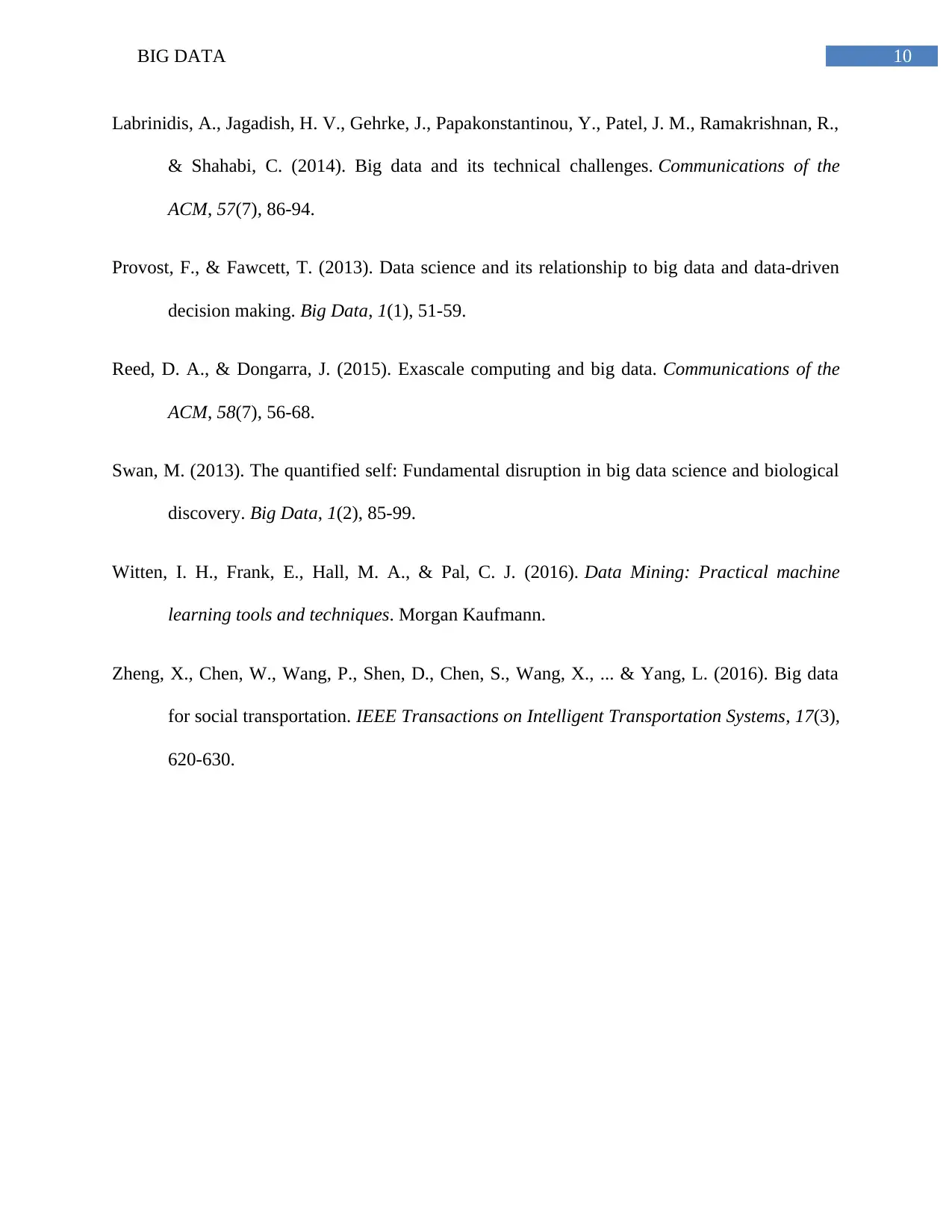
10BIG DATA
Labrinidis, A., Jagadish, H. V., Gehrke, J., Papakonstantinou, Y., Patel, J. M., Ramakrishnan, R.,
& Shahabi, C. (2014). Big data and its technical challenges. Communications of the
ACM, 57(7), 86-94.
Provost, F., & Fawcett, T. (2013). Data science and its relationship to big data and data-driven
decision making. Big Data, 1(1), 51-59.
Reed, D. A., & Dongarra, J. (2015). Exascale computing and big data. Communications of the
ACM, 58(7), 56-68.
Swan, M. (2013). The quantified self: Fundamental disruption in big data science and biological
discovery. Big Data, 1(2), 85-99.
Witten, I. H., Frank, E., Hall, M. A., & Pal, C. J. (2016). Data Mining: Practical machine
learning tools and techniques. Morgan Kaufmann.
Zheng, X., Chen, W., Wang, P., Shen, D., Chen, S., Wang, X., ... & Yang, L. (2016). Big data
for social transportation. IEEE Transactions on Intelligent Transportation Systems, 17(3),
620-630.
Labrinidis, A., Jagadish, H. V., Gehrke, J., Papakonstantinou, Y., Patel, J. M., Ramakrishnan, R.,
& Shahabi, C. (2014). Big data and its technical challenges. Communications of the
ACM, 57(7), 86-94.
Provost, F., & Fawcett, T. (2013). Data science and its relationship to big data and data-driven
decision making. Big Data, 1(1), 51-59.
Reed, D. A., & Dongarra, J. (2015). Exascale computing and big data. Communications of the
ACM, 58(7), 56-68.
Swan, M. (2013). The quantified self: Fundamental disruption in big data science and biological
discovery. Big Data, 1(2), 85-99.
Witten, I. H., Frank, E., Hall, M. A., & Pal, C. J. (2016). Data Mining: Practical machine
learning tools and techniques. Morgan Kaufmann.
Zheng, X., Chen, W., Wang, P., Shen, D., Chen, S., Wang, X., ... & Yang, L. (2016). Big data
for social transportation. IEEE Transactions on Intelligent Transportation Systems, 17(3),
620-630.
1 out of 11
Related Documents
Your All-in-One AI-Powered Toolkit for Academic Success.
+13062052269
info@desklib.com
Available 24*7 on WhatsApp / Email
![[object Object]](/_next/static/media/star-bottom.7253800d.svg)
Unlock your academic potential
Copyright © 2020–2025 A2Z Services. All Rights Reserved. Developed and managed by ZUCOL.



